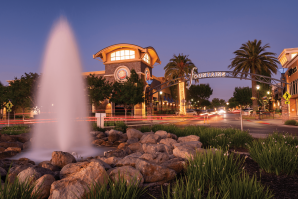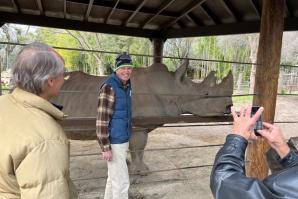“Someone told me it’s all happening at the zoo. I do believe it, I do believe it’s true …”
Until this past April 30, those Paul Simon lyrics about the Central Park Zoo in New York City could just as easily have summarized what was happening here.
The on-again/off-again saga of relocating the Sacramento Zoo from its longtime William Land Park location to the city of Elk Grove, a little under 13 miles away, had seemed like an idea whose time, available acreage, freeway access and enthusiastic support had come. Then it seemed like it hadn’t, and the project was unceremoniously killed.
What had, at first, sounded like a sure thing turned out to be dead before arrival.
Money was always an issue, to be sure — and it always will be when you dare to dream big — but another matter that wasn’t being discussed, at least not as much as it used to be, was accreditation. In fact, the Sacramento Zoo’s potential downgrading of its accreditation by the Association of Zoos and Aquariums could reportedly happen just four years from now. Has that issue disappeared from the discussion(s)?
The original cost of moving the Sacramento Zoo to Elk Grove was estimated at more than $300 million and grew from there. But when the planning began, the initial vision — for what the Sacramento Zoological Society’s interim CEO Robert Churchill called in a statement “a 65-acre, state-of-the-art zoo” — proved myopic.
As has been reported elsewhere, the society had been hoping for a location with an onsite lodge, new classrooms and exhibits, as well as an event pavilion, all combining to allow the Sacramento Zoo’s animal population to increase to 94 species.
But as the project’s budget was updated, it imploded, with the number of species dropping spectacularly to 30. What happened?
The first thing that needs to be understood is that it was the Sacramento Zoological Society, not the City of Elk Grove, whose members decided to pull the plug. As Churchill said in the same statement, “As design work proceeded, it became clear that the new zoo’s size would be dramatically reduced, and critical features would be eliminated to control construction costs and stay within budget.”
I have to ask a few questions:
How could professional planners have underestimated the pricetag for a project of this magnitude? What didn’t the planners plan on?
With all due respect to both parties, if the members knew they were going to be attempting a project of this magnitude, shouldn’t they have secured financial commitments to match what seemed to be the political will (but maybe wasn’t) to get this ship launched?
Have we thought too provincially about this project? Why not expand the society’s board to include financial heavy-hitters and conduct an international search for someone who’s run other zoos (if possible), but more importantly, major entertainment amenities?
How much discussion has there been about privatizing the zoo? I was surprised to discover recently that only 15 percent of zoos in the United States aren’t privately owned. I think we tend to think of zoos as being strictly municipal departments or divisions. Maybe we start thinking “public/private” partnership — a genuine one, not the one between the Zoological Society and Elk Grove but between those entities and a thoroughly private, successful business?
According to a City of Elk Grove staff report dated February 12, 2025, there was a projected cost of $302 million and an economic impact of at least $295 million — plus the addition of 395 jobs. It’s not a totally fair comparison, but the San Diego Zoo’s economic impact on the region was estimated to be $1.52 billion in 2018.
Why don’t the zoo and City of Elk Grove enter into an agreement to take a six-to-nine-month period to recast a well-thought-out strategic plan — one that considers the things that can throw off the best-laid plans, such as a pandemic, a recession, a natural disaster, a political upheaval? Crisis management is best done before you’re managing the crisis.
I want our region to think “big.” There is no reason we shouldn’t make this happen. But it will take the right people, the right project and proper connections. I visualize a celebrity like the late Betty White, who loved animals, getting behind a project like this with both money and celebrity. And while we’re at it, how about a botanical garden as part of the space, and maybe a Smithsonian-like museum next door?
Maybe we start over, this time armed with the collected data and realistic sense of what needs to be done to make the zoo a commercial attraction (like a Disneyland or a Knott’s Berry Farm) as well as a cultural amenity that would draw people here from around the state and maybe from around the country.
What do you think?
Winnie Comstock-Carlson
President and Publisher
–
Stay up to date on business in the Capital Region: Subscribe to the Comstock’s newsletter today.
Recommended For You

Sleepy Suburbs? No Way
These Capital Region cities are buzzing with energy and ambition
A generation ago, Sacramento was the undisputed king of commerce and culture in our region. But the once-quiet suburbs are growing up fast. In fact, thanks to years of quiet community building, the edge cities are leading the way in defining the modern Capital Region.

The Other J. Gregory
A late banker shares a name with a Sacramento Zoo rhinoceros. Coincidence?
Jan Gregory, a banker, passed away in May in Sacramento. Five days later, the front page of the Sacramento Bee announced that the Sacramento Zoo had acquired a rare white rhinoceros named J. Gregory.

We Need More Real Food and Less Chemicals for Good Health
FROM THE PUBLISHER: As our seasons change to spring and summer, I look forward to shopping in the many farmers markets in our region. I’ve always been a fan and believe that health is even more important than financial wealth. As Dr. Hans Diehl said at a conference I attended: “Health isn’t everything, but without it everything is nothing.” I live by that notion, and thoroughly believe it.

Some Burning Questions on Wildfires
FROM THE PUBLISHER: As it is with all catastrophes, there’s plenty of blame to go around. I guess this can be a useful exercise at some point, but it won’t rebuild people’s homes, restore their most valued possessions or, most importantly, stop this from becoming an annual, recurring heartbreak. We need to ask and answer some obvious questions.




